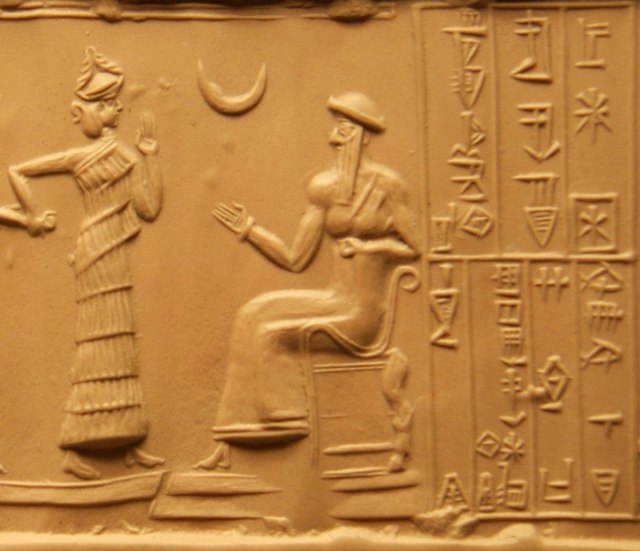King of Sumer and Akkad was a royal title in Ancient Mesopotamia combining the titles of "King of Akkad", the ruling title held by the monarchs of the Akkadian Empire with the title of "King of Sumer". The title simultaneously laid a claim on the legacy and glory of the ancient empire that had been founded by Sargon of Akkad and expressed a claim to rule the entirety of lower Mesopotamia. Despite both of the titles "King of Sumer" and "King of Akkad" having been used by the Akkadian kings, the title was not introduced in its combined form until the reign of the Neo-Sumerian king Ur-Nammu, who created it in an effort to unify the southern and northern parts of lower Mesopotamia under his rule. The older Akkadian kings themselves might have been against linking Sumer and Akkad in such a way.
Cylindrical seal of Shulgi of Ur (r. c. 2094–2047 BC). The inscription reads "To Nuska, supreme minister of Enlil, his king, for the life of Shulgi, strong hero, King of Ur, King of Sumer and Akkad".
Cuneiform inscription Lugal Kiengi Kiuri 𒈗𒆠𒂗𒄀𒆠𒌵, "King of Sumer and Akkad", on a seal of Shulgi (r. c. 2094–2047 BC). The final ke4 𒆤 is the composite of -k (genitive case) and -e (ergative case).
Depiction of an enthroned Ur-Nammu of Ur (r. c. 2112–2095 BC) from one of his cylindrical seals. Ur-Nammu introduced the title of King of Sumer and Akkad to assert his rule over the entirety of lower Mesopotamia.
Tiglath-Pileser III (r. c. 745–727 BC) on a stela from the walls of his palace (now in the British Museum, London). Tiglath-Pileser was the first Assyrian king in centuries (except for a claim by Shamshi-Adad V) to use the title of King of Sumer and Akkad following his conquest of Babylon.
Ur-Nammu founded the Sumerian Third Dynasty of Ur, in southern Mesopotamia, following several centuries of Akkadian and Gutian rule. His main achievement was state-building, and Ur-Nammu is chiefly remembered today for his legal code, the Code of Ur-Nammu, the oldest known surviving example in the world. He held the titles of "King of Ur, and King of Sumer and Akkad".
Enthroned King Ur-Nammu, founder of the Third Dynasty of Ur, on a cylinder seal. Inscription of the upper segment: "Ur-Nammu, the Great man, King of Ur". The name of King Ur-Nammu (𒌨𒀭𒇉) appears vertically in the upper right corner.
Ur-Nammu built the great Ziggurat of Ur.
Ur-Nammu dedication tablet for the Temple of Inanna in Uruk. Inscription "For his lady Inanna, Ur-Nammu the mighty man, King of Ur and King of Sumer and Akkad": 𒀭𒈹 Dinanna.... "For Inanna-" 𒎏𒂍𒀭𒈾 Nin-e-an-na.... "Ninanna," 𒎏𒀀𒉌 NIN-a-ni.... "his Lady" 𒌨𒀭𒇉 UR-NAMMU.... "Ur-Nammu" 𒍑𒆗𒂵 NITAH KALAG ga.... "the mighty man" 𒈗𒋀𒀊𒆠𒈠 LUGAL URIM KI ma.... "King of Ur" 𒈗𒆠𒂗𒄀𒆠𒌵𒆤 LUGAL ki en gi ki URI ke.... "King of Sumer and Akkad"
Stele of Ur-Nammu, University of Pennsylvania Museum of Archeology and Anthropology.







